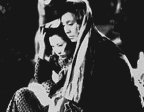The Story of the Last Chrysanthemum opens to a majestic shot of the Shintomi Theater in the heart of Tokyo in 1888, as a popular acting troupe performs a lush, enthusiastically received Kabuki play. Passionate about the theater and eager to perfect his craft, Kikunosuke (Shotaro Hanayagi) seems destined to continue the revered tradition of his adoptive father, the great actor, Kikugoro V (Gonjuro Kawarazaki). But Kikunosuke lacks the personal discipline and skilled execution required to become a great actor. His attempts to solicit constructive criticism inevitably result in hypocritical flattery and empty reassurances of talent. Only his infant brother’s nurse, Otoku (Kakuko Mori), counsels him: “Please don’t be satisfied with flattery or shallow popularity”. Kikunosuke is encouraged by Otoku’s honesty, and becomes inspired to apply himself into becoming a great actor. Kikunosuke’s focused attention towards Otoku fuels gossip among the household servants, and Otoku is dismissed for fraternizing with a master of the house. In anger, Kikunosuke defies his family’s demands and turns his back on his privileged life in order to marry Otoku and establish himself as actor on his own merits. However, without the legacy of his famous family, Kikunosuke quickly sinks into obscurity, resorting to occasional work as an itinerant actor. As the young couple lead an increasingly difficult life of poverty far away from Tokyo, Kikunosuke falls into despair.
Kenji Mizoguchi creates an exquisitely realized film on love, perseverance, and the pursuit of artistic excellence in The Story of the Last Chrysanthemum. Through odd camera angles and changes in elevation, Mizoguchi uses visual imbalance as a metaphor for social inequity. Note the mesmerizing angled tracking shot of an early encounter between Otoku and Kikunosuke, as Otoku provides an honest critique of Kikunosuke’s performance, reflecting their social disparity despite compatibility. Another scene shows the reunited couple traversing an inclined street, after a popular actor is driven away by carriage. The visual incongruity further serves to reinforce the insurmountable challenges, both personally and professionally, that lay ahead of them. The Story of the Last Chrysanthemum is a serenely beautiful, haunting, and profoundly moving portrait of the interminable power of love, the cruel inescapability of social class, and the ultimate price of fame.
© Acquarello 2001. All rights reserved.
